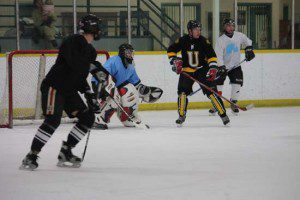
They called it “the winter classic.”
They were right about one thing. The outdoor NHL game at the Ralph Wilson Stadium in Orchard Park, N.Y. (where the NFL Buffalo Bills play) Tuesday afternoon got plenty of winter. Despite all the technology to make the playing surface seem as if it were just another Hockey Night in Canada game – heated benches, regulation boards and glass, pyrotechnic fanfare and over 70,000 screaming fans – a heavy and constant snowfall reminded everybody that nature often determines the game’s outcome. Even Don Cherry recognized that fact.
“You can see the players are happy,” he said before the game. “But they gotta be careful. There’s a lot of money out there.”
Cherry, not surprisingly, expressed the worry of all NHL officialdom at that moment. Would the broadcast novelty attract an American audience? What would happen if any of the multi-millionaire players got injured because of the natural ice conditions? And, finally, would it look like a real game of hockey?
I’ve got news for Cherry, Bettman and the all the pros on skates Tuesday afternoon: I saw more “classic” hockey over these holidays than 10 NHL winter classics combined. No, I didn’t score overnight tickets to the Czech Republic to watch Team Canada’s Juniors play. Nor did I see any pros play or any sanctioned game, for that matter. I saw classic hockey on the frozen ponds around my community. In fact, over New Years I saw several “classic” games.
Out on the natural surface there were three or four games in progress. Some had the sophistication of snowdrifts as boards, roughly squared corners and even the odd meshed net or two. But most demonstrated all the basics of the game – players equipped only with sticks and skates, passing among players of all skill levels, mostly offence and no goalies. No refs. No whistles. No scorekeeping. Just moms, dads, boys and girls all playing a seamless and seemingly endless game of all-day hockey. The result? All players went away with a common rush. Everybody had participated. Everybody had fun.
As far as I’m concerned, any game of pond hockey, shinny or pick-up on an outdoor surface speaks more to the purity of the game than anything concocted by an NHL commissioner or all the greed driving pro-hockey franchises these days. Of course, all the sports pundits, official statisticians and commentators have argued about its origin. Shinny, some say, the Greeks invented in 500 B.C. Others claim ancient Danes and 12th century Anglo-Saxons attached bones to their feet, skated on ice and chased a ball with field hockey sticks. Siberian sources report Russian boys batting “an orange ball about the frozen taiga.” In Ireland, the game was called “hurley,” in Scotland “shinty” and in England “bandy.”
There’s plenty of argument about the origin of the great Canadian pastime too. The diaries of a man named Horsey claim the game was born in Kingston, Ont., in 1847. The great hockey play-by-play broadcaster Foster Hewitt, wrote in his memoirs that “Montreal authorities emphatically declare that their city was the original home of ice hockey in 1875. I tend to believe the version offered by Thomas Chandler Haliburton (a.k.a. Sam Slick) who recalled his schooldays at King’s College, near Windsor, N.S. There, he wrote in 1803, “And the boys let out racin’, yelpin’, hollerin’ and whoopin’ like mad with pleasure, and the playground and the game of hurley on the long pond.”
Call it what you like, locate it where you like, the purest form of the game of hockey comes from amateur, recreational playing out of doors. And there, despite every commercial enterprise attempt to corrupt it, is where it will remain. Nothing in winter is more Canadian than outdoor impromptu hockey.
By the way, you might have noticed during Tuesday’s so-called “Winter Classic,” (Pittsburgh beat Buffalo 2-1 in a shootout victory) next to the manicured outdoor surface on which the Penguins and the Sabres battled the elements, there was a smaller ice surface. It looked a bit like a practice area. In fact, it was a shinny playing area for kids. Apparently former Sabres’ goaltender Dominik Hasek donated $1 million to create it. Why? To give members of his kids’ hockey program a taste of scrimmaging in front of crowds. Most barely noticed, except the kids who played on and on throughout the pro game next door.
That’s exactly the way it should be in “classic” hockey – playing just for the fun of it.